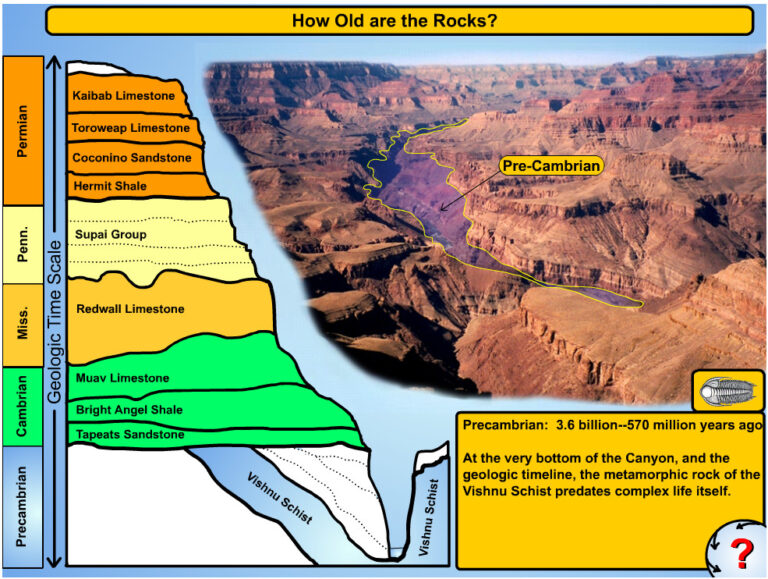We love developing highly creative interactive exhibits for museums and science centers.
This page lists a few our past projects.
HoloSandsTM Augmented Reality Sandbox
We are the developers of HoloSands, the world’s most advanced interactive sandboxes:
HoloSands brings a regular old sandbox to life with living biomes, rain and water flow, volcanoes, lava, and simulation of environmental conditions in more than 14 unique biomes. As you move the sand, your biome responds and the sounds of birds and animals from that part of the world fill the air.
Grand Canyon Layer and Fossil Explorer
Imagine standing at the rim of the Grand Canyon. The vistas are awe inspiring. There are so many colors, so many layers, so much complexity to that beauty.
But what does it all mean?
To help visitors put all of that beauty in context, we developed a special touch screen application, that let them explore the layers and geological history of the canyon. On the left each layer showed on a vertical cutout of the canyon. Tapping on a layer highlighted its position in the canyon–as viewed from the visitor’s location–as a narrator pronounced its name and gave a scientific description of its composition and fossils. You could look up and see for yourself exactly where that layer was before you, putting the real world in context. You could also tap on the image and it would highlight the layer to which that part of the canyon belongs.

Art With a Point of View
One of our founder’s first projects, was an exhibit for the Huntsville Museum of Art. They were highlighting a rarely seen part of their collection and called it “Art With a Point of View“. For this exhibit, they invited 30 local high school art students to tape video interviews. Each student gave their interpretation of individual pieces, expressing rich and varied views of what the art meant to them.
We worked with the museum to build a beautiful customized touch screen kiosk, which blended perfectly with the clean lines and beauty of the exhibit hall. We also developed a “hardened” version of Internet Explorer, that we call Exhibit Browser™. It allowed webpages to be safely used by museum visitors on the touch screen kiosks. It prevented access to system functions like the start bar, or dangerous system settings; thus making it safe to use in a museum setting.
Virtual Time Traveller
Today we take Augmented/Virtual/Mixed Reality for granted. With devices like the Apple Vision Pro, Microsoft HoloLens, and A/R apps for your cell phone, mixed reality is an everyday reality. In the early 2000’s though, things were really different! Those hardware platforms did not exist yet, and commercial 3D graphics engines were a new innovation. Our founder worked for a company developing one of the first augmented reality devices for museum applications. It was called the Virtual Time Traveller.
It was designed to work much like the coin operated binoculars so popular at tourist destinations like Niagara Falls or the Grand Canyon. But instead of binoculars, it used a camera at the front of the “scope” to capture a live image. A computer mounted in the base used software our founder helped develop, which overlaid 3D objects on the live image and displayed it to the visitor. Sensors in the swivel head let the program know where the scope was looking, which allowed the virtual objects to stay “stuck in place” as the camera moved.
We placed two of the units on the upper balcony of the Smithsonian Institution’s Museum of Natural History in Washington, D.C. Visitors could look down on the rotunda and see the elephant exhibit come to life. Scattered around the rotunda were “hotspots” that could trigger a T-Rex, or other dinosaurs, to come to life and roam around the exhibit space; or hotspots that would trigger video clips describing the history of the museum and its many exhibit halls.
Personal Browser
Long before the iPhone was a glimmer in Steve Jobs’ eyes, our founder worked for a company developing the world’s first mobile touch screen/portable multi-media device for museums. Hardware was primitive then–with a max resolution of 320 x 240–and the processing power was laughable compared to today’s devices, but we still created an app that could display graphics and video presentations. Visitors could carry the device with them, safely wrapped in a custom designed cushioned shell, and listen to a narrator guide them through exhibit spaces. In the sample below, visitors could explore the history of the U.S. Space Program–including historical videos, interviews with astronauts, and even spinnable 3D models using QuickTime VR (bet it has been a long time since you have heard that term!).